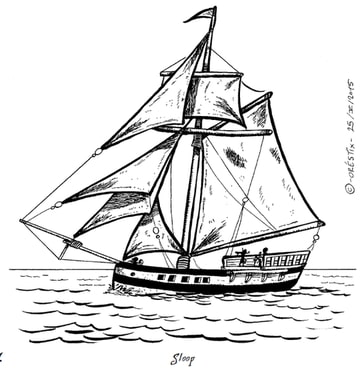I thought I'd get some boats on the table this weekend and try out a set of rules. I had bought an electronic copy of Galleys and Galleons by Ganesha Games and liked the way it looked on the page. The proof is, as ever, in the pudding however... I decided to try the rules solo, as written to see how the gameplay felt. Obviously I had already started tweaking the rules to do things they way I wanted (Why am I like this!?! I started wargaming at the height of WRG and Barkerism; I should be accepting the words as written on the holy page!) I decided to use the three ship models that I have based and ready to go (I have a few others painted but not based.)

The two sides were an English Merchant Galleon and a pair of Dutch privateers; a sloop and a Brigantine. The rules come with multiple scales so that it can be used with smaller playing areas and different sizes of model ships. I used a card table, which worked fine for this size of encounter. The ships are characterised by just two statistics: their Quality and their Combat value. The Combat score for a ship cannot be more than 1 point higher than the Quality score, so this means that the larger ships with higher Combat scores are at a disadvantage when rolling for initiative. So really Quality is a slight misnomer, it is more like a combination of agility and crew quality, whatever the naval word for that should be. The upshot is that smaller vessels can be easier to activate giving them a balancing advantage against gun-laden behemoths.

In my small playtest the English galleon outgunned either of its Dutch opponents individually but I was interested to see if the quality advantage swung things back their way. I decided the best tactic for the Dutch was to try to get on both sides of the enemy ship to try for a raking shot and the threat of boarding from two directions. The English weren’t too keen on this outcome so used the wind advantage to try to pick on the sloop before the combined attack could develop. This was when I realised that, as a merchant ship, the English galleon had a minus on all shooting so was hard pressed to cause damage to the enemy. Luckily for the English my aggressive tactics caused the Dutch sloop to miscalculate its course and collide with the stern of the English ship. Now the Dutch (and me) discovered that this was a bad idea against a ship with a reinforced hull and took 2 damage. The decision to grapple and board was equally poor against a high sided galleon and the sloop took another point of damage as their boarding party was repelled.

The sloop’s heroics/idiocy did pin the English ship in place long enough for the Dutch brigantine to fire a close range broadside into her. This caused major rigging damage and a permanent loss of speed for the galleon. The sloop took the first opportunity to cut grapples and put some distance between them. With three hits it counted as “crippled”. The sloops three white initiative dice had now all changed to red and each time a 1 is rolled on activation something bad will happen including the chance they will surrender to a nearby enemy. Any further damage once crippled causes a critical hit which includes the chance of sinking or catching fire.

The remaining Dutch privateer was finding out the hard way that it had perhaps bitten off more than it could chew. Although it damaged the St George (the English galleon) even a raking shot was not fatal against the galleon’s reinforced hull. The English ship was quite prepared to battle it out but a slight change in the wind direction meant that it woul;d have to turn into the wind to get closer to the brigantine. With the damaged rigging this was going to be a slow affair. I decided to stop there as a decisive outcome was looking unlikely.

I did enjoy the short playtest of Galleys and Galleons. I do like the activation mechanism where there is an inbuilt risk in trying to do too much with any one ship and worse outcomes possible once damaged. The rules are at the simple end of the scale but with interesting tailoring possible for individual ships by applying different characteristics (for example the sloop had “Razée” which allows additional move distance and the Galleon had “Reinforced Hull”, as previously mentioned.) There is little in the way of book-keeping required, although I will probably make up ship sheets as a reminder of which characteristics a vessel has and the effect during the game. Definitely worth trying some more and I can already see possibilities of house rules that I might try. (I know, I know…![]() )
)




No comments:
Post a Comment